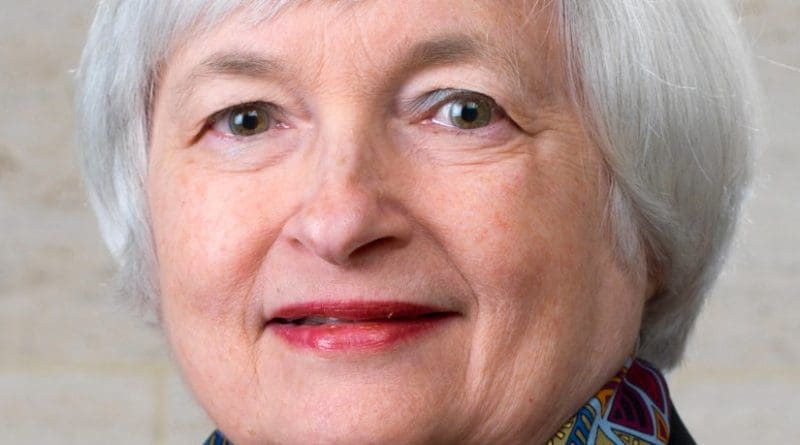Sham Lift-Off Day At The Fed: A Long Journey Into Monetary Night Begins – Analysis
By Brendan Brown*
Marcel Proust wrote that in the stock exchange an ill emperor is already dead and a besieged city already fallen. How, then, has Federal Reserve Chairman Janet Yellen so far escaped marketplace derision for having supervised a lengthy—and, by now, obviously flawed—monetary experiment in quantitative easing, near-zero interest rates, and perpetual “low” inflation? Oddly enough, very few people are booing. Quite the contrary, Ms. Yellen’s latest “when will the Fed raise rates by 25 basis points?” show has proved a ratings bonanza, riveting the financial world and business press for weeks on end.
What are the signs that this monetary experiment is failing? Its designers promised that it would boost and expedite post-recession economic expansion, but the opposite has occurred; the expansion has been abnormally slow. Then, too, there is the practical—and quite predictable—result of those near-zero interest rates: a succession of speculative, boom-and-bust cycles in commodity extraction industries and emerging markets—and continuing, fever-level temperatures in several key asset markets across the globe.
It is a vicious circle: nervousness about the baleful effects of past Fed policy produces frenzied, obsessive curiosity about future Fed policy. Transcripts of Ms. Yellen’s every spoken word, no matter how elliptical or banal, are passed around and analysed like holy texts. And the growing size, influence, and (dare one say it) psychopathology of her audience affects the Fed chief in turn. Their anticipation becomes too intense. She can no longer sit still and do nothing—in this case, further postpone “rate lift-off”—simply for fear of losing face. So, otherwise paralyzed, the Fed proceeds. One is reminded of Emperor Franz-Josef’s infamous remark in 1914 about a looming conflict with Serbia: “there is no going back.”
The lift-off day Janet Yellen could not postpone—despite an emerging crisis in the critical high-yield credit market (with several major funds liquidating portfolios or suspending redemptions)—came Wednesday of this week, December 16. The good news: It was not an earth-shaking event like World War I. The bad news: It was hardly an “event” at all. It was deliberately inconsequential; the 25 basis-point rate hike is trivial.
A genuinely significant Fed announcement would have included a plan to quickly reduce the central bank’s massive balance sheet of long-maturity government bonds: a negotiated accord with the Treasury Department to swap those holdings for short-term T-bills—and subsequently sell those T-bills on the open market so as to absorb excess reserves in the banking system. That would begin to return the aggregate monetary base to its normal, long-run path and enable natural, supply-and-demand market forces to once again determine interest rates.
The abandonment of central-bank rate manipulation—by this or any other means—is clearly not what Ms. Yellen intends to do, however.
This week’s 25 basis-point rate hike would not have taken place if Janet Yellen had modestly taken her cue from how a free market in rates would operate. The plunge of speculative temperatures in the high-yield credit market and the related surge in demand for liquidity would have caused risk-free short-term rates to fall or at least stay pinned to zero (where the zero rate boundary applies). Instead Chief Yellen decided to proceed with the lift-off while aiming to neutralize its impact by making clear that barring a surge in the US economy or in wage inflation any further rate rises would be only “gradual.”
The US equity market seemed to welcome the Yellen “fudge” on the day of the press conference. But if this was the Santa Claus rally it lasted barely a day. The speculative bust in the high-yield credit space (for which the catalyst has been a further plunge in oil prices) is proving to be more powerful.
The bubble in high-yield credit–driven by income-starved investors chasing better returns—was a major source of power to the private equity industry. Stocks have boomed in large measure because private equity firms have been able purchase them with highly leveraged arbitrage based on the issue of over-priced—and all too often very risky—debt. That boom will now likely burst, and it’s possible that poor liquidity and opaque pricing will spread outright panic.
Any such crisis in the private equity industry would further expose and exacerbate already existing weaknesses in major sectors of the U.S. and global economy: ultra-cheap sub-prime automobile finance, aircraft leasing, and real estate, for example. As investors sour on private equity we should expect contagion to spread to the closely related venture capital industry. The news will not be good for public equity, either. And as the investment-grade corporate bond market also loses liquidity—and spreads there (relative to Treasuries) rise—one has to doubt that even the most imaginative financial engineering schemes will be enough to sustain a continuing climb in earnings-per-share ratios while overall U.S. profits fall.
And so sham lift off-day may well prove to be a coincidentally important stage in the present U.S. business cycle transitioning from expansion to recession. If so, some Fed critics will doubtless spin a tale of direct causation. The Fed and its supporters will recite a counter-narrative of irresponsible speculation on Wall Street undermining otherwise sensible policies, and insist on the need for even more policing and regulation going forward. But neither story will quite be true. The real truth is that the Federal Reserve’s monetary experiment was well along on the road long before Ms. Yellen stepped to her podium on December 16.
About the author:
*Brendan Brown, Hudson Institute Adjunct Fellow
Source:
This article was published at the Hudson Institute


They just open the borders wider to a huge group of uneducated sheeple for their ever increasing government low income loan packages, grants and grunt work force to hold up and sustain the corrupt system for an even longer run. That’s how they do it.